This site is made possible by its sponsors.
Please visit them!
c. or ca. - Abbreviations for circa, meaning about; approximately. Also a common abbreviation for canvas, "oil on canvas" being abbreviated o/c.
C - When found on a tube or other container of paint, indicates a fugitive color.
|
letter code |
degree of color permanence |
|
AA |
highest |
|
A |
standard |
|
B |
less than standard, though fairly durable |
|
C |
fugitive |
C. - Abbreviation for Celsius (after Anders Celsius), which is the same as Centigrade, a temperature scale on which the freezing point of water is 0°, and the boiling point of water is 100° under normal atmospheric pressure.
© - See copyright.
cabinet of wonders - See Wunderkabinett.
cabochon - Polished gemstone of rounded, unfaceted form.
CAD or C.A.D. - Abbreviation for computer-assisted design. In the production of computer graphics, this is more likely to refer to architectural and engineering design work than for graphic design work.
Also see digital image.
cadavre exquis - See exquisite corpse.
cadmium - A metal found
in several compounds: cadmium oxide, cadmium carbonate, cadmium
chloride, cadmium sulfate, and cadmium sulfide. In paints,
inks, enamels, glazes,
and dyes, and permanent pigments (reds, oranges,
and yellows) are prepared from cadmiums, mostly cadmium sulfate.
It is also used in electroplating, in solder
for aluminum, as a constituent of
easily fusible alloy, as a
deoxidizer in nickel plating,
in process engraving,
and in nickel-cadmium batteries. Cadmiums are toxic.
The following chart describes six different types of ceramic glazes, each carrying levels of concerns about cadmium, in order to help you to determine which are safe to use on dinnerware — vessels for food or drink.
|
1. Dinnerware safe. Contains no cadmium. |
Another resource about cadmiums:
Also see lead, lead glaze, and poison.
 caduceus - A herald's wand or staff, especially in ancient
times. In Greek mythology,
a winged staff with two snakes
twined around it, carried by Hermes (Mercury is his Roman name).
As an insignia, the caduceus is also a traditional symbol
of the medical profession.
caduceus - A herald's wand or staff, especially in ancient
times. In Greek mythology,
a winged staff with two snakes
twined around it, carried by Hermes (Mercury is his Roman name).
As an insignia, the caduceus is also a traditional symbol
of the medical profession.
(pr. kə-DOO-see-əs)
A sculpture in which a caduceus appears:
![]()
Johan Gregor van der Schardt (Dutch, 1530-
about 1580), Mercury, Bologna, Italy, 1570-1580, bronze, height 45 1/4 inches (115 cm),
J. Paul Getty Museum, Malibu, CA. Van der Schardt has given Mercury
several attributes that
signify his speediness: his sandals and hat bear wings. The caduceus
he carries remind us of Mercury's role as patron of science. Mercury is the Roman name
for the god called Hermes by Greeks.
cairn - A mound of stones serving as a memorial or monument, or simply as a marker.
(pron. kayrn)
Examples:
Cairn to Commemorate the Battle of Culloden, Scotland.
![]()

![]()
Andy Goldsworthy (British, contemporary),
Cairn, 1997. See earth
art.
calcagnolo - A claw chisel with two long points. This is the Italian name for what in France is called a pied de biche.
Also see bush hammer.
calendar painting - painting having pleasing subject matter, but rarely having lasting value as art.
Also see academic, bad art, bland, buckeye, kitsch, low art, paint-by-number, picturesque, and popular culture.
calendering - In papermaking, the process of pressing paper in order to give it a smooth surface, running it between rollers under strong pressure. Supercalendering produces an even smoother, polished finish.
calidarium - The hot-bath section of a Roman bathing establishment.
caliper or calipers - An instrument 
 used
to measure the thickness or
diameter of an object.
It consists of a pair of movable metal
or wooden arms with curved, pointed
ends, hinged together; or, having a fixed and a movable arm on
a graduated stock.
used
to measure the thickness or
diameter of an object.
It consists of a pair of movable metal
or wooden arms with curved, pointed
ends, hinged together; or, having a fixed and a movable arm on
a graduated stock. The two
kinds pictured here are among the most common types, however there
are many others. A sculptor can take an exact measurements from
a
 model with a caliper. Inverted measurements,
as well as scaled enlargements
and reductions can be obtained with calipers.
model with a caliper. Inverted measurements,
as well as scaled enlargements
and reductions can be obtained with calipers. These are proportional
calipers. By tightening a wing-nut one can establish a vertex
anywhere along the central section of this caliper's length. They
can enlarge a measurement up to 5 times, or reduce one to as much
as 1/5, from measurements taken from either an inside (negative)
space or from a positive space.
(pr. KA-lə-pər)
Also see pantograph, pointing and pointing machine.
calotype - An early photographic process, it was patented in 1840 by William H.F. Talbot (English, 1800-1877), the first process to employ a negative to produce a positive image on paper. Also known as Talbotype.
Examples:

William Henry Fox Talbot, The Open Door,
England, April 1844, salt print from a calotype negative, 5 7/16
x 6 5/8 inches (14.0 x 16.8 cm), J. Paul Getty Museum, Malibu,
CA.
Félix Teynard (French, 1817-1892), Large Speos - View taken from the Sand Slope (Temple of Ramesses II), Abu Simbel (Abou-Sembil. Grand spèos - vue prise de la coulée de sables), 1851-52 (printed 1853-1854), salted paper print from calotype negative from Égypte et Nubie, sites et monuments les plus intéressants pour l'étude de l'art et de l'histoire, deuxième partie, pl. 153, Cleveland Museum of Art.
calyx-krater - A type of krater.
camaïeu - A painting technique, in which the painter creates a monochromatic image by employing two or three tints of a single pigment without regard to local or realistic color. Or, a woodblock print that imitates highlighted drawing on tinted paper.
An example of a camaïeu in the latter sense:

Hans Baldung Grien (German, 1484/5-1545),
The Witches, 1510, monochromatic
woodcut, two plates
(gray and black), 0.378 x 0.258 m, Louvre.
Also see chiaroscuro.
camcorder - A small hand-held video camera. Also see monitor.
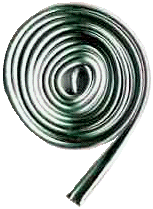
![]()
came - The channeled lead strips used in producing stained glass. It is commonly available in two kinds, distinct in cross-section: "H" came is used between pieces of glass at the interior of a design, while "C" and "U" came is used around pieces of glass at the design's outer edges. ("C" has a rounded exterior, while "U" has a squared exterior.) The pieces of came are then soldered together, and often installed in an iron framework to create a window.
cameo - A small-scale low relief in a stratified or banded material, usually a gemstone such as onyx or sardonyx, but also in calcite alabaster or shell or glass, in which the ground is of one color and the figure in relief in another color or colors.
Example cameos:

Hellenistic Alexandria, The Gonzaga Cameo, 3rd century BCE,
height 15.7 cm, State Hermitage
Museum, St. Petersburg, Russia. The rulers of Egypt, King Ptolemy
II Philadelphus and his wife Arsinoe, are portrayed as gods from
the Greek pantheon. See Greek art and Hellenistic.

Augustus Saint-Gaudens (American, 1848-1907),
Mary,
Queen of Scots, cameo (Williams version), 1873, U.S.
Dept. of the Interior, Nat. Park Service, Saint-Gaudens National
Historic Site, Cornish, NH.
Also see intaglio.

![]()
camera lucida - A device much like an opaque
projector, which replaced it, using a prism (lens)
and mirrors to project the image
of an external object onto
a flat surface
so that its image may be traced.
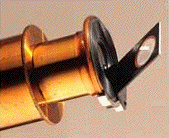
![]() Replacing the camera obscura, it was invented in the
seventeenth century, but not widely used until the nineteenth.
Literally, "lighted room." Artist David Hockney (English,
lives and works in USA, 1937-) theorized in 2001 that many more artists than have previously been acknowledged — Jean-Auguste-Dominique Ingres (French, 1780-1867) for instance — used camera lucidas (and other lensed devices), causing some
controversy over whether this is true, and whether it was in any
ways unethical.
Replacing the camera obscura, it was invented in the
seventeenth century, but not widely used until the nineteenth.
Literally, "lighted room." Artist David Hockney (English,
lives and works in USA, 1937-) theorized in 2001 that many more artists than have previously been acknowledged — Jean-Auguste-Dominique Ingres (French, 1780-1867) for instance — used camera lucidas (and other lensed devices), causing some
controversy over whether this is true, and whether it was in any
ways unethical.
Also see copy, likeness, mirror, pinhole camera, Realism, representation, simulacrum, and simulation.
camera obscura - The origin of the present day camera. In its simplest form it consisted of a darkened room or box with a small hole through one wall. Light rays could pass through the hole to transmit an inverted image of the scene outside the room onto a flat surface on its inside. It was first mentioned by Aristotle in the fourth century BCE, and employed through the centuries as an aid to drawing. These are Latin words, literally meaning "dark room."
Examples:
French, about 1750, Théâtre de l'univers (Theater of the Universe), a portable camera obscura built into a folio binding stamped Théâtre de l'univers, made with wood, metal, and glass; open: 22 1/8 x 21 3/4 x 14 3/8 inches; Getty Research Institute, Werner Nekes Collection, Malibu, CA. See theater.

Abelardo Morell (American, born Cuba, 1948-), Light Bulb, 1991, photograph of a corrugated cardboard box, fitted with a lens, so that light from a light bulb beside it is cast onto a wall of the box's interior. Morell has made numerous photographs of rooms that he has transformed into camera obscuras. See transformation.
Also see camera lucida, lens, mirror, pinhole camera, projection, projector, sight, and theater.
camera-ready - In graphic design, two-dimensional artwork that is ready be given to a person who will photograph it so that printed versions can be produced. Although a physical image or piece of copy is still sometimes produced, and is employed in this process, digital imaging has largely eliminated this step. When a camera is needed, copy is considered camera-ready when it is in its final version, clean, flat, and either dark ink on paper or a pasteup. Also see image capture.
camouflage - The means, effect, or act of concealing someone or something — making a person or thing indistinguishable from his or its surroundings. Also, deception, and disguise, usually for either aesthetic or defensive reasons. Numerous living things owe their species' evolutionary success to camouflaging aspects of their appearance. Humans have employed camouflaging colors, textures, materials, or patterns in the design of numerous artifacts in order to conceal them. This is in some ways the opposite of emphasis, a kind of simulation of transparency or erasure. Modernist architect Frank Lloyd Wright (American, 1856-1959) often built with materials found on a building's site to increase the degree to which it would blend into its environment — to make it less visually intrusive. Costumes designed to reduce the visibility of hunters and soldiers are among the most overt human applications of camouflage, each style intended for use in specific environs. It was in the late 19th century that military uniforms began to be designed to make soldiers appear drably inconspicuous. Before that time, uniforms were typically bright and bold. Since the late 20th century, camouflage fabric patterns have been chosen increasingly for reasons other than concealment. Sometimes, ironically, camouflage designs have been employed in persuit of fashion — to make their users stand out.
(pr. CA-mə-FLAHZH)
Some examples, each a one square foot detail of a shirt:
![]()

![]()
Australian
army.
![]()
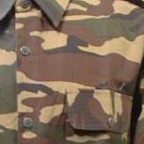
Bangladeshi
army.
![]()
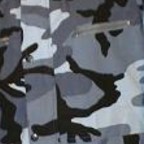
![]()
Chinese
marines.
![]()

French
army.
![]()
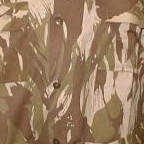
![]()
Indian
army, semi-desert environment. This is used by artillery and
infantry posted in Rajasthan — a semi-desert area. As of 2003,
it is also being worn by Indian peacekeepers serving in Angola.
![]()
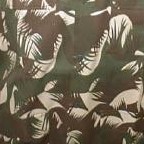
Indian
army, jungle environment.
![]()
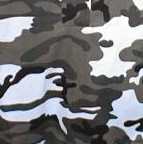
![]()
Indian
army, urban environment.
![]()

Mauritanian
army.
Example in fine art:

Andy Warhol, Camouflage, 1987, portfolio of eight silkscreen prints; each composition: 38 x 38 inches (96.5 x 96.5 cm); each sheet: 38 x 38 inches (96.5 x 96.5 cm); printer: Rupert Jasen Smith, New York; edition: 80; Museum of Modern Art, NY. See Pop Art .
Also see accent, compare, contrast, juxtaposition, and Prairie style.
camp - Those parts of popular culture commonly considered kitsch, artificial, vulgar, or banal, but which acquire contemporary appreciation, especially which are the most artificial and exaggerated. The things enjoying the attention of camp taste include many old movies, 1950s furniture designs, 1960s fashion, cross-dressing, and drag cultures. The camp sensibility arose simultaneously with the development of Pop Art in the early 1960s, when low art objects became high art's subjects. Also see brummagem.
campanile - In Italian architecture, a bell-tower, usually near, but rarely attached to, a church. Sometimes they were connected by cloisters to a church. They were first a product of the Romanesque period in Italy. Campanili (the plural form) in northern Italy are often civic monuments rather than parts of church complexes, were symbols of power, and also served as watch-towers.
(pr. CAM-pə-NEE-lə)
Examples:
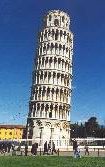
Because it is about 12º away from vertical, this campanile is commonly
known as the Leaning Tower of Pisa. Built in 1174, this
tower has eight stories of arcades,
with a diameter of 52 feet,
its original height
was 151 feet 3 inches. The belfry — atop the tower — was added
in 1350. Much work has been done recently to arrest this campanile
from leaning further. See dot and perpendicular.

Italy, Campanile of St. Mark's, Venice, originally
built in the early 16th century, rebuilt since its collapse in
1902 to its original design.
![]()
![]() camphor
flakes - A solid, slow vaporizing fumigant
for moths or larvae, often used in storing objects
in a closed room or cabinet.
camphor
flakes - A solid, slow vaporizing fumigant
for moths or larvae, often used in storing objects
in a closed room or cabinet.
Also see art conservation.
Canadian Group of Painters - See Group of Seven.
candela - A unit of luminous intensity equal to 1/60 of the luminous intensity per square centimeter of a blackbody radiating at the temperature of solidification of platinum (2,046 K). Also called candle.
candelabrum - A candle holder or lamp with several arms or branches. The Hebrew word "menorah" means a "holder of light" or candelabrum. The plural form is candelabra.
Example:

Henry van de Velde (Belgian, 1863-1957), Candelabrum, 1898-1899, electroplated bronze, Musées Royaux d'Art et d'Histoire, Brussels. See Art Nouveau.
candlestick - A stand with a socket or spike for one candle.
candle - A formed mass of wax with one or more wicks that provides illumination when ignited. Also a unit of luminous intensity also called candela. Also see candelabrum and candlestick.
cane 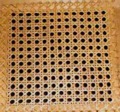 and
caning - A natural, fibrous
weaving material
used in the production of baskets
and chair seats, and in wrapping the joints of wicker furniture. Cane is cut into long strips
from the inner layer or skin of the rattan
plant. Various widths are available.
Stains do not penetrate cane
well, and paints don't adhere
well either. Fortunately cane has a naturally occurring glossy
finish, making varnishes
unnecessary.
and
caning - A natural, fibrous
weaving material
used in the production of baskets
and chair seats, and in wrapping the joints of wicker furniture. Cane is cut into long strips
from the inner layer or skin of the rattan
plant. Various widths are available.
Stains do not penetrate cane
well, and paints don't adhere
well either. Fortunately cane has a naturally occurring glossy
finish, making varnishes
unnecessary.
In glass, a cane is a thin, monochrome rod, or a composite rod consisting of groups of rods of different colors, that are bundled together and fused to form a polychrome design that is visible when seen in cross-section, as in millefiori.
Examples in the fibrous sense:

American, Shaker Community, Enfield, NH,
Side
Chair, c. 1840-1860, birch, caned seat, seat height
15 Inches.

Ludwig Mies van der Rohe (German-American,
1886-1969), designer, "MR" Armchair, 1927, chrome-plated steel and painted
caning, 31 1/2 x 22 x 37 inches (80 x 55.9 x 94 cm), Metropolitan
Museum of Art, NY. This was developed from a 1924 design for
a cantilevered chair by Mart Stam.
It was introduced by Mies van der Rohe at the 1927 Stuttgart
exhibition and has remained in production ever since. Mies van
der Rohe was the last director of the Bauhaus design school in Dessau, from 1930
until its closing in 1932.
Also see bamboo, raffia, reed, and rush.
canon - In art, the body of unquestionably important artists (DWMs — dead white males) and works. Until recently the canon was seldom challenged, and changed at a sluggish pace. Now it's being relentlessly challenged by art historians and critics recovering forgotten and ignored artists (especially by women, non-whites, and outsiders) both within and outside the Western world. The scope of what is considered art has been widening as new fields, including photography, performance art, video, crafts, and design, are added to what amounts to an ever-increasing canon. Postmodernism, however, has put in question the very idea of an irreducible list of masters and masterpieces. So, when referring to the canon today, one should specify what sort of canon one means.
canopic jar - An ancient Egyptian vase, urn, or jar used as a container for an embalmed human organ.
Examples:

Egypt, Canopic Jars, from a burial during the reign of Amenophis III (1391 - 1357 BCE), limestone, 89 x 35 cm, Louvre.

Egypt, Western Thebes, Canopic Jar with a Lid in the Shape of a Royal
Woman's Head, c. 1349-36 BCE
or shortly after, Dynasty 18, late reign of Akhenaten, New Kingdom,
alabaster with
glass and stone inlays,
height 20 1/2 inches (52.1
cm), Metropolitan Museum of Art, NY. The carving is thought to
be a specific member of the Egyptian royal family. The massive
wig of layered curls is a headdress favored by Akhenaten's queen,
Nefertiti, their six daughters, and a minor queen, Kiya. The
jar was found in Thebes in a tomb in the Valley of the Kings
that has aroused a great controversy concerning the events surrounding
Akhenaten's death and succession.
Egypt, Canopic Jars of Prince Hornakht, 874-850
BCE,
Dynasty 22, reign of Osorkon II, alabaster, Egyptian Museum, Cairo.
Also see vessel.
cantharos - See kantharos.
cantilever - A structural member which projects beyond a line of support.
Also see balance, cantilever, counterpoise, equilibrium, equipoise.
![]()
canvas - Commonly used as a support
![]()

![]() for
oil or acrylic
painting, canvas is a heavy
woven fabric made of flax or cotton. Its surface
is typically prepared for painting by priming
with a ground. Linen — made of flax — is the standard canvas, very strong, sold by
the roll and by smaller pieces. A less expensive alternative to
linen is heavy cotton duck, though it is less acceptable (some
find it unacceptable), cotton being less durable, because it's
more prone to absorb dampness, and it's less receptive to grounds
and size. For use in painting,
a piece of canvas is stretched tightly by stapling or tacking it to a stretcher
frame. A painting done
on canvas and then cemented to a wall or panel is called marouflage.
Canvas board is an inexpensive, commercially prepared cotton canvas
which has been primed and glued to cardboard,
suitable for students and amateurs who enjoy its portability.
Also, a stretched canvas ready for painting, or a painting made
on such fabric. Canvas is abbreviated c., and "oil on canvas"
is abbreviated o/c.
for
oil or acrylic
painting, canvas is a heavy
woven fabric made of flax or cotton. Its surface
is typically prepared for painting by priming
with a ground. Linen — made of flax — is the standard canvas, very strong, sold by
the roll and by smaller pieces. A less expensive alternative to
linen is heavy cotton duck, though it is less acceptable (some
find it unacceptable), cotton being less durable, because it's
more prone to absorb dampness, and it's less receptive to grounds
and size. For use in painting,
a piece of canvas is stretched tightly by stapling or tacking it to a stretcher
frame. A painting done
on canvas and then cemented to a wall or panel is called marouflage.
Canvas board is an inexpensive, commercially prepared cotton canvas
which has been primed and glued to cardboard,
suitable for students and amateurs who enjoy its portability.
Also, a stretched canvas ready for painting, or a painting made
on such fabric. Canvas is abbreviated c., and "oil on canvas"
is abbreviated o/c.
About canvas:
Other sites concerned with canvas:
Also see easel and paint-by-number.
![]()
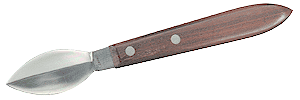
![]()
canvas scraper - A tool used to scrape oil or acrylic paint from a canvas. A canvas scraper has a curving blade so that its effect is evenly distributed, avoiding cuts and grooves.
capital letter - In typography, uppercase letters (A, B, C, D, E, F, G, H, etc.) In c. 114 CE, an inscription was chiseled into the base of a column in Trajan's Forum, Rome. That inscription had most of the capital letters known today. Until the sixth century, all inscriptions were in capital letters. And to this day we continue to use them in various ways — for the first letters of important words in titles, proper nouns, etc. They got their alternative name — uppercase — from the standard location in which typesetters stored them. Though visually powerful, whole words written in capital letters should be used sparingly, because they are difficult to read, and may suggest shouting.
A design composed of one or more letters, typically the initials of a name, used as an identifying mark, can be a monogram, and might be used as a logo (also known as a logogram or logotype). An oversized ornamental capital letter used in printing may be called a factotum. One designed with representation that carries narrative qualities may be termed historiated.
Examples of capital letters:
![]()

Roman Capital letters. See serif.
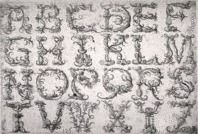
Daniel Hopfer (German , c. 1470-1536), Alphabet of Roman Capital Roman letters with
metaphorical ornaments, 15th-16th century, etching, 15.6 x 22.6 cm (image) inches,
Fine Arts Museums of San Francisco, CA. See ornament.
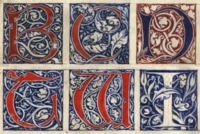
William Morris (English, 1834-1896), Initial Letters, c. 1840s, designed for
Love is Enough, a book printed by Morris' Kelmscott Press,
each letter 45 x 45 mm, U of Florida.

Eric Gill (English, 1882-1940), Inscription 'Ex Divina Pulchritudine',
1926, Hoptonwood stone relief, 30.6 x
45.7 x 3.8 cm, Tate Gallery, London. This Latin inscription
of capital letters is an aphorism
meaning, "The beauty of God is the cause of the being of
all that is."
![]()
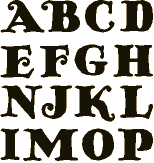
16 capital letters of a late 20th century
font.
![]()
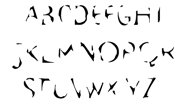
![]()
Commonworld, c. 2000, letters
that are distressed and partly
missing. Available from Fontscape.com. See implied,
lacuna, letterform,
and typeface.

Modell Envelo, c. 2000, a font with
a jittery high-tech mood. Available from Fontscape.com.
![]()
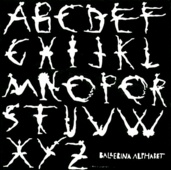
![]()
Schomer Lichtner (American, 1905-2006), Ballerina Alphabet, 1990, serigraph. Living in Wisconsin, Lichtner was reknowned for paintings of ballerinas and dairy cows and his regionalist murals. See anthropomorphism and New Deal art.

Abelardo Morell (American, born Cuba, 1948-), Water Alphabet, 1998, photograph of a wood panel on which capital letters have been drawn with water.
Also see lowercase, monument, Roman art, and text.
caption - A brief text explaining an image, whether on a wall, in a vitrine, a book, magazine, Web page, etc. Typically a caption tells something about the artist and something about the particular work shown. A caption is sometimes called the credit lines or label.
Example:

Count de Meurs, (Netherlandish), Drawings in a Letter, 1493, Library of
Zutphen, Netherlands. Manuscripts
dating back to the Middle
Ages often used sequential
pictures accompanied by text, or sometimes
even used text-balloons for captions as in this example. See
cartoon.
The text above is a caption accompanying the picture beside it.
Also see description.
capture device - See scanner.
https://inform.quest/_art